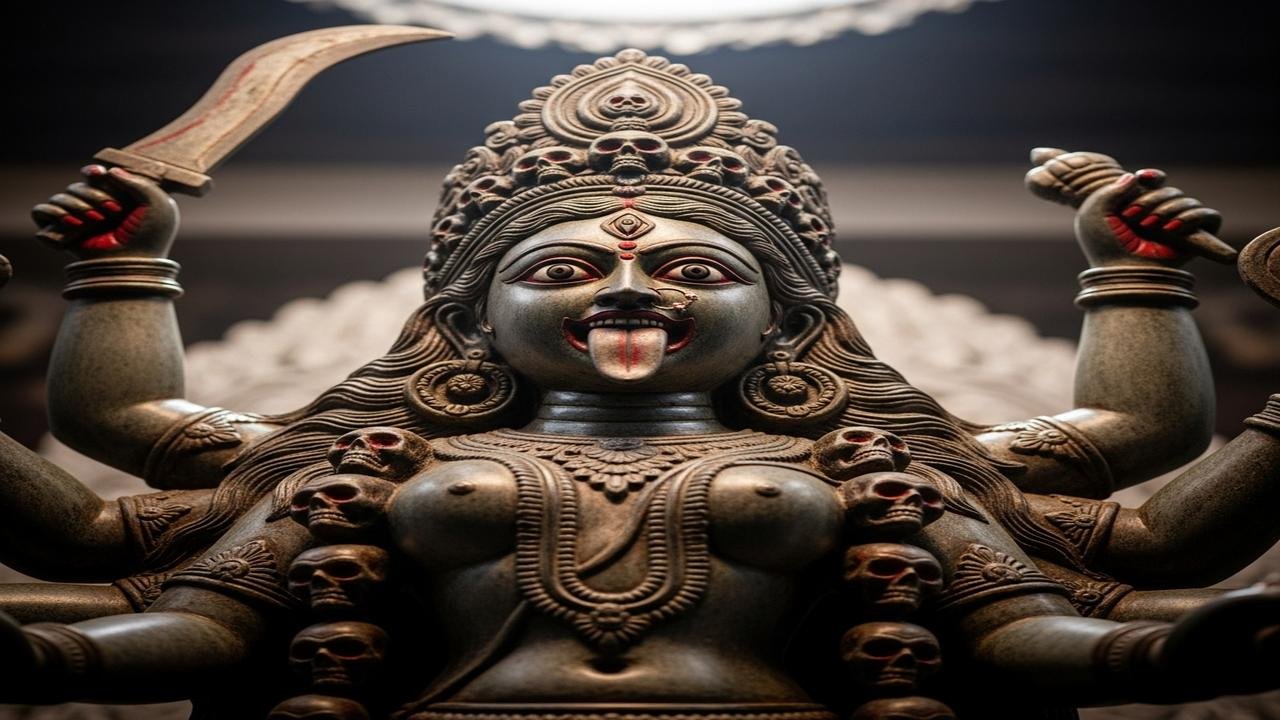Goddess Kali: Fierce Form From Devi Mahatmya Explained

Why is Goddess Kali shown fierce?
The figure of Goddess Kālī — often translated as “the black one” and closely associated with kāla (time, death, the ending of things) — appears dramatic, terrifying, and exuberantly powerful. That fierceness is deliberate: it communicates roles that range from cosmic destruction to intimate liberation. Different texts, temples and communities emphasize different aspects, so a single explanation will always be partial. Below I outline major scriptural origins, iconographic symbols and living interpretations people give to Kali’s fierce appearance.
Origins in myth and scripture
Creation in the Devi Mahatmya
One of the clearest scriptural origins is the Devī Māhātmya (part of the Markandeya Purāṇa). In the episode where the demon Raktabīja multiplies with every drop of his blood, the goddess Durga creates a ferocious form — Kālī — to drink the blood and prevent the enemy’s regeneration. This martial, blood-consuming form explains many violent elements in Kali’s iconography: her open mouth, extended tongue and emphasis on severed heads or blood in some images.
Tantric and Purāṇic developments
Tantric literature and later Purāṇic texts elaborate Kālī’s role. In many Śākta (goddess-centered) texts she is not merely a battlefield avatar but the ultimate power (śakti) that brings about cyclical dissolution. In some Śaiva readings she is the active energy of Śiva; in other traditions she is worshipped as the supreme reality herself. These layers account for both the ferocity and the metaphysical language used about her.
Iconography and what each element means
Kali’s features are symbolic rather than purely literal. Common elements and widely offered readings include:
- Dark or black skin: a symbol of the void, the womb of existence, non-differentiation and the infinite ground beyond form. Black absorbs all colours; metaphorically, it signifies the end of names and forms.
- Dishevelled hair: freedom from social norms, uncontrolled energy, and the raw power of nature beyond tame civilisation.
- Protruding tongue: multiple readings exist — a sign of bloodlust in the battlefield story; an expression of shame and humility in the popular Bengal story where she steps on Shiva and bites her tongue; or a symbol of the irreversible act of consuming illusion and ego.
- Many arms and weapons: the capacity to act simultaneously in many cosmic tasks — creation, preservation and destruction; the weapons denote the destruction of obstacles and inner enemies like ego, ignorance and attachment.
- Necklace or girdle of skulls: interpreted as severed egoic identifications, the letters of the Sanskrit alphabet (the source of speech and creation), or a catalogue of human limitations. It registers mortality and the transience of the individual self.
- Standing on Śiva: in Bengal iconography she often stands on a supine Śiva. Interpretations differ — some read it as the power of active energy (Kālī) at play on passive consciousness (Śiva); others stress a domestic scene where Kālī’s furious dance is checked by Śiva’s presence, indicating the containment of wild force by awareness.
Philosophical and spiritual meanings
Across schools, Kālī’s fierceness is not gratuitous cruelty. Key spiritual readings include:
- Time and dissolution: As an aspect of kāla (time), Kālī brings endings that make new beginnings possible. Destruction here is a function of natural cycles.
- Destroyer of ego: Her severing of heads and drinking of blood symbolise cutting through false identity and attachments — dramatic metaphors for inner transformation.
- Protector and mother: In many devotional contexts Kālī is theultimate mother (Mātā), fierce in protecting her children from harm. Fierceness implies compassion through radical intervention rather than mere gentleness.
- Transcendence of dualities: Her blackness and nakedness point to a reality beyond caste, gender roles, and social boundaries. Tantric practitioners see her as a route to direct experience of non-dual consciousness.
Rituals, festivals and living worship
Kāli is worshipped in many ways: public puja at Kali Puja (especially in Bengal at the new moon of Kartik, often coinciding with Diwali), devotional songs, temple rituals and tantric sadhana. Historically, some communities offered animal sacrifice in certain contexts; many modern temples substitute symbolic offerings. Tantric practices associated with Kālī can involve strict disciplines — novices should approach such methods with guidance and awareness.
Note: If you plan fasting, breathwork or other intense practices associated with goddess sadhana, consult an experienced teacher and, if needed, a medical professional.
Why fierce, yet often called mother?
The apparent contradiction — ferocious appearance and maternal devotion — is intentional. In many Hindu devotional frameworks, the same power that destroys obstacles is the one who nurtures and leads toward liberation. The ferocity protects and clears; the maternal aspect receives and transforms. For devotees, Kālī’s terrible forms are expressions of an intimacy that is willing to use radical means to cut chains and grant freedom.
Contemporary readings and social meanings
In modern India, Kālī has been reinterpreted in multiple ways: as a symbol of feminine agency, a figure of anti-colonial resistance in late 19th- and 20th-century Bengal, and a spiritual archetype for psychological transformation. Academics, artists and activists draw on her imagery to challenge conservative gender roles, while many devotees continue traditional temple practices with deep reverence.
Conclusion
Kālī’s fierceness is a rich, multi-layered language of symbol, myth and practice. It expresses cosmic process (time and dissolution), psycho-spiritual aims (cutting ego and liberating the soul), social critique (transgression of norms) and deep maternal care (protecting and transforming devotees). Interpretations vary across scriptures and traditions, and respectful study or practice benefits from guidance within a living lineage.
